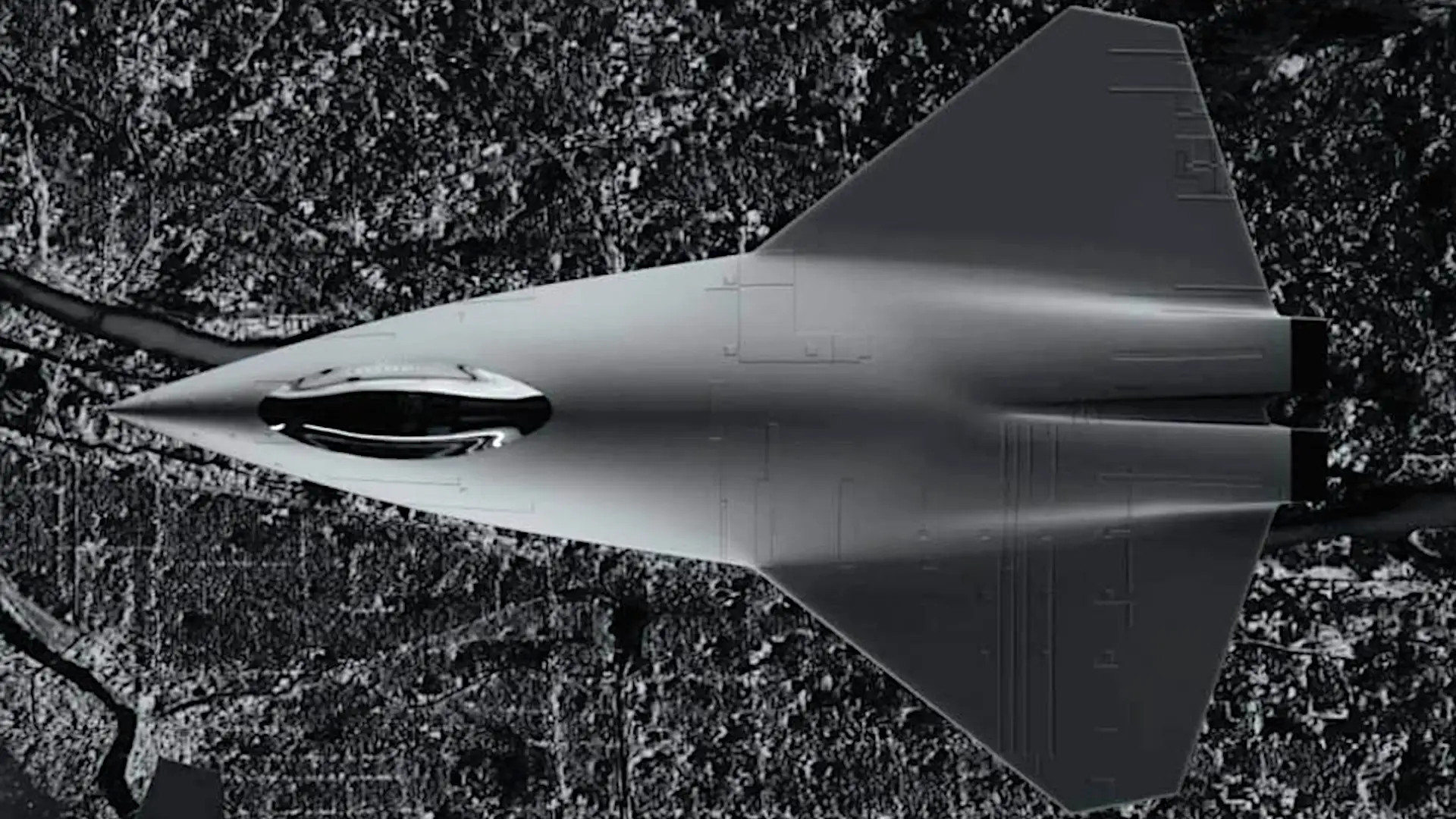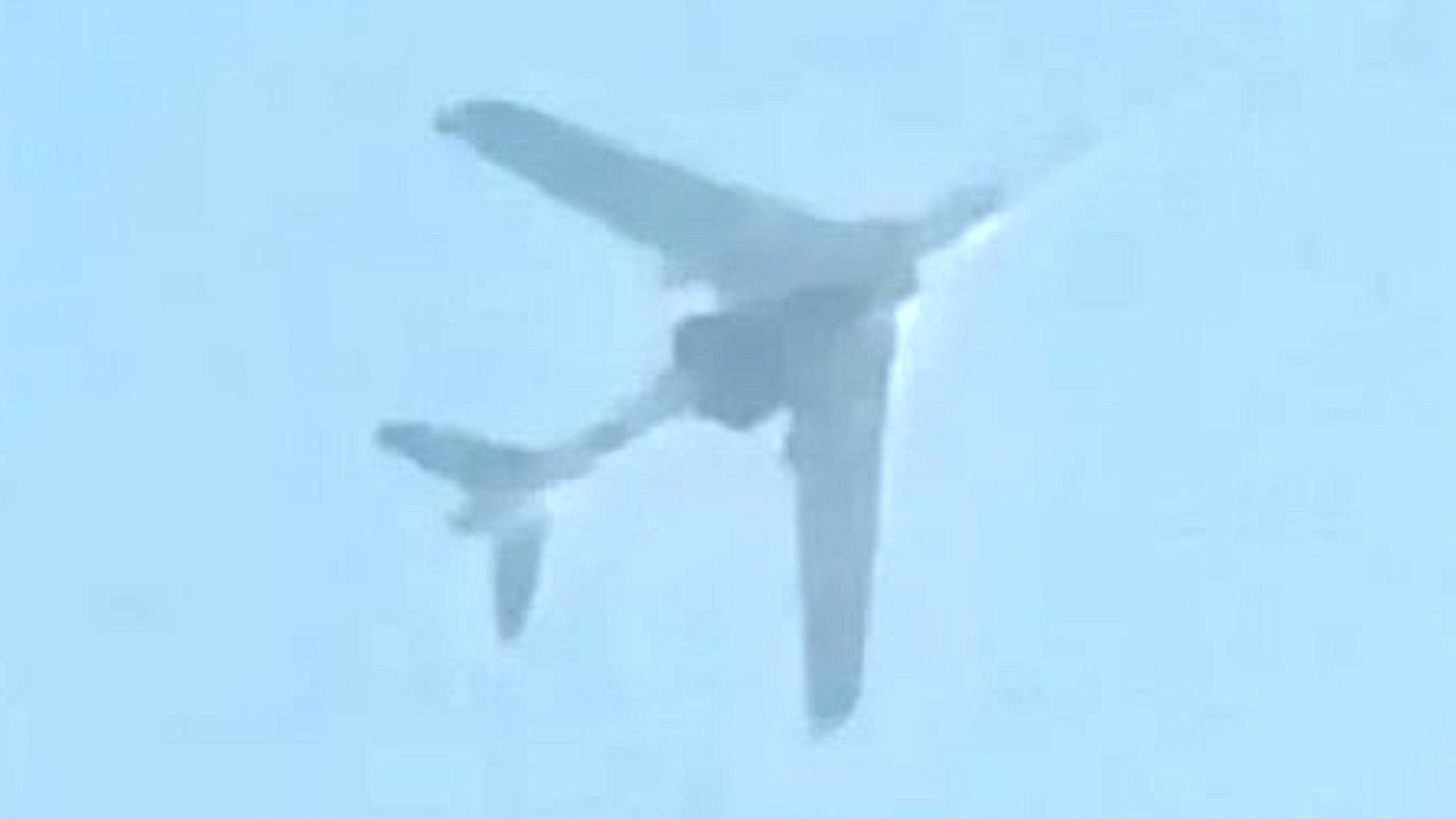An image has emerged purporting to show a Chinese H-6 bomber variant carrying what looks to be a large very dark-colored aerospace vehicle under its central fuselage. The object is not a WZ-8 rocket-powered supersonic spy drone, which is designed to be air-launched from a version of the H-6. What can be seen of its general shape and size does not appear to directly conform to any other known operational or in-testing Chinese air-launched systems, which leaves its identity a mystery.
The picture of the H-6 in question flying overhead first emerged on the Chinese social network Weibo before starting to circulate more widely online last Friday. The image shows no outright signs of having been manipulated or fabricated, but that is a very real possibility that must be kept in mind.
The image immediately drew attention as the potential first sighting of an H-6 carrying a WZ-8. This is clearly not the case, though we will come back to that later.
The WZ-8 first appeared publicly in 2019 at a parade in Beijing marking the 70th anniversary of the founding of the People’s Republic of China. Later that year, evidence emerged that these drones were actually in operational service at least to a limited degree. You can read more about WZ-8 and its intended intelligence-gathering mission here.

Since 2019, the U.S. military has assessed that a subvariant of the H-6M cruise missile carrier aircraft, sometimes referred to as the H-6MW, is at least one of the launch platforms for the WZ-8. This was disclosed in classified documents leaked online last year by a member of the Massachusetts Air National Guard.
There is also the H-6N air-launched ‘mothership’ variant, which is based on the H-6K version and has been observed carrying different types of air-launched ballistic and novel hypersonic missiles. H-6Ns differ from H-6MWs primarily in that the former has a semi-recessed area under the main fuselage for carrying outsized payloads, while the latter carries its loads directly under the fuselage. The H-6N also has an inflight refueling probe as is found on some examples of the H-6K and otherwise shares the redesigned front end found on that variant. H-6Ms have the glazed nose found on earlier versions of the H-6 and the Soviet Tu-16 Badger from which they are derived. There is the potential for some overlap in what the H-6MW and H-6N can carry.


As already noted, what is seen in the new picture of the H-6 with the large payload underneath is definitely not a WZ-8. Altogether, “it seems indeed to be larger, wider, and feature a different wing geometry [than the WZ-8],” Andreas Rupprecht, a Chinese aerospace expert and contributor to The War Zone, told us.


It is possible that what we are seeing here is a new variant or derivative of the WZ-8. However, this would be a major redesign that is significantly different from the known WZ-8 configuration both in terms of size and planform.
There has also been speculation that the H-6 could be carrying an example of the MD-22 hypersonic testbed, or a related test article. A mockup of the MD-22 first emerged at the Zhuhai Airshow in 2022. As The War Zone wrote at the time:
“It’s unclear how close this design may be to coming to fruition and whether there is any expectation that it could be developed in an operational platform. The design is reportedly expected to be 10.8 meters long, have a wingspan of 4.5 meters, weigh around 1 ton empty and have a maximum takeoff weight of some 4 tons, and be able to hit speeds of up to Mach 7 on sorties that could see the drone cover distances up to 8,000 kilometers. The range figure seems unlikely, but it may just represent aspirational ideas or even similar concepts with more realistic metrics that are under development.”
“Whatever the case, the MD-22 does mirror similar developments in the United States, such as the Stratolaunch Talon-A, which is intended primarily to support research and development and test and evaluation activities related to other hypersonic systems, including aircraft and weapons. The Chinese military actively pursuing a number of hypersonic capabilities that the MD-22 could help in the development of, at least in part, among other potential uses.”
It remains unclear if the MD-22 is intended to be powered by an air-breathing engine of some kind. However, the mockup seen more than a year ago, as well as accompanying renders, point this way, showing a design with what could be a ventral air intake and a single large engine exhaust at the rear.
There are some similarities in the general shape and configuration of the MD-22 mockup and what is seen underneath the H-6 in the picture that has recently emerged. It also looks to be roughly one-third as long as the H-6 carrying it, which would also be in line with the previously stated expected length of a real MD-22 (just under 35.5 feet or 10.8 meters). The baseline version of the H-6 has a length of just over 114 feet (34.8 meters), with newer versions being only slightly longer.
Another possibility is that we’re seeing something new that is broadly similar in form and function to the WZ-8 and/or the MD-22, or is part of the development of such an air vehicle. A larger take on the general concept of the WZ-8 or an operationalized reusable hypersonic air vehicle akin to the MD-22 could be capable of performing multiple missions, including testing, strike and intelligence, surveillance, and reconnaissance. In recent years, the U.S. Air Force has been exploring the idea of a potentially reusable air-launched hypersonic air vehicle that could be used for these same missions. Regardless, China has been investing very heavily in hypersonic technologies for many years and is in some ways ahead of the U.S. in this developmental arena. Reported tests of vehicles now dating back many years could very well have included air launched hypersonic vehicles. With this in mind, even a WZ-8 follow on capable of true hypersonic speeds would be a fairly conservative step for China.

China’s state-run aviation industry has also been heavily investing in the development of reusable spaceplanes. Designs have emerged in recent years that could be air-launched, as well as ones that use more traditional space launch rockets to get into space. One reusable spaceplane design, known as Shenlong, or a related test article, has at least been carried aloft for flight testing underneath an older H-6 variant in the past. However, the shape of the mystery object does not align with typical spaceplane designs, making this a less likely candidate for the mystery object.

There is always the possibility that what this H-6 was carrying is something completely different from the options already presented here. The general shape of the mystery object is similar in some respects to the fictional Darkstar hypersonic aircraft that Lockheed Martin helped create for the movie Top Gun: Maverick, and that the company has said could reflect real capabilities. It is also broadly reminiscent of some notional design concepts that American aviation firms have put forward around the U.S. Air Force’s very real, but highly classified Next Generation Air Dominance (NGAD) program, although, this would not fit a Chinese 6th generation fighter initiative.


Without a clearer look at the mystery object we just cannot say now what it might be with any certainty.
What is known is that Chinese aviation firms have and continue to produce an ever more diverse array of increasingly more advanced drones, as well as crewed aircraft. The country has also made significant advances in the development of hypersonic weapons and other air vehicles in recent years. This includes a still nebulous orbital weapon system, which you can read more about here.
When it comes to the H-6 family, these aircraft make sense in general as platforms for air-launching or otherwise helping to flight-test a variety of advanced air vehicles and aerial weapon systems, especially outsized ones, as well as employing such things operationally. In many ways, the H-6’s overall utility both as a weapon system and a test platform mimics that of the larger U.S. B-52, the core design of which is roughly the same age as the Tu-16.

Whatever the mystery object seen under the H-6 bomber in the picture that has emerged online might be, if it is indeed being flown around in this way, there will hopefully now be other sightings that offer new clues as to its identity.
Contact the author: joe@twz.com
